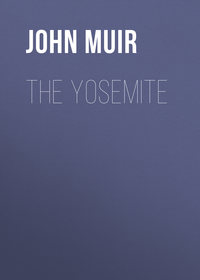 полная версия
полная версияThe Mountains of California
Our way from Murphy's to the cave lay across a series of picturesque, moory ridges in the chaparral region between the brown foot-hills and the forests, a flowery stretch of rolling hill-waves breaking here and there into a kind of rocky foam on the higher summits, and sinking into delightful bosky hollows embowered with vines. The day was a fine specimen of California summer, pure sunshine, unshaded most of the time by a single cloud. As the sun rose higher, the heated air began to flow in tremulous waves from every southern slope. The sea-breeze that usually comes up the foot-hills at this season, with cooling on its wings, was scarcely perceptible. The birds were assembled beneath leafy shade, or made short, languid flights in search of food, all save the majestic buzzard; with broad wings outspread he sailed the warm air unwearily from ridge to ridge, seeming to enjoy the fervid sunshine like a butterfly. Squirrels, too, whose spicy ardor no heat or cold may abate, were nutting among the pines, and the innumerable hosts of the insect kingdom were throbbing and wavering unwearied as sunbeams.
This brushy, berry-bearing region used to be a deer and bear pasture, but since the disturbances of the gold period these fine animals have almost wholly disappeared. Here, also, once roamed the mastodon and elephant, whose bones are found entombed in the river gravels and beneath thick folds of lava. Toward noon, as we were riding slowly over bank and brae, basking in the unfeverish sun-heat, we witnessed the upheaval of a new mountain-range, a Sierra of clouds abounding in landscapes as truly sublime and beautiful—if only we have a mind to think so and eyes to see—as the more ancient rocky Sierra beneath it, with its forests and waterfalls; reminding us that, as there is a lower world of caves, so, also, there is an upper world of clouds. Huge, bossy cumuli developed with astonishing rapidity from mere buds, swelling with visible motion into colossal mountains, and piling higher, higher, in long massive ranges, peak beyond peak, dome over dome, with many a picturesque valley and shadowy cave between; while the dark firs and pines of the upper benches of the Sierra were projected against their pearl bosses with exquisite clearness of outline. These cloud mountains vanished in the azure as quickly as they were developed, leaving no detritus; but they were not a whit less real or interesting on this account. The more enduring hills over which we rode were vanishing as surely as they, only not so fast, a difference which is great or small according to the standpoint from which it is contemplated.
At the bottom of every dell we found little homesteads embosomed in wild brush and vines wherever the recession of the hills left patches of arable ground. These secluded flats are settled mostly by Italians and Germans, who plant a few vegetables and grape-vines at odd times, while their main business is mining and prospecting. In spite of all the natural beauty of these dell cabins, they can hardly be called homes. They are only a better kind of camp, gladly abandoned whenever the hoped-for gold harvest has been gathered. There is an air of profound unrest and melancholy about the best of them. Their beauty is thrust upon them by exuberant Nature, apart from which they are only a few logs and boards rudely jointed and without either ceiling or floor, a rough fireplace with corresponding cooking utensils, a shelf-bed, and stool. The ground about them is strewn with battered prospecting-pans, picks, sluice-boxes, and quartz specimens from many a ledge, indicating the trend of their owners' hard lives.
The ride from Murphy's to the cave is scarcely two hours long, but we lingered among quartz-ledges and banks of dead river gravel until long after noon. At length emerging from a narrow-throated gorge, a small house came in sight set in a thicket of fig-trees at the base of a limestone hill. "That," said my guide, pointing to the house, "is Cave City, and the cave is in that gray hill." Arriving at the one house of this one-house city, we were boisterously welcomed by three drunken men who had come to town to hold a spree. The mistress of the house tried to keep order, and in reply to our inquiries told us that the cave guide was then in the cave with a party of ladies. "And must we wait until he returns?" we asked. No, that was unnecessary; we might take candles and go into the cave alone, provided we shouted from time to time so as to be found by the guide, and were careful not to fall over the rocks or into the dark pools. Accordingly taking a trail from the house, we were led around the base of the hill to the mouth of the cave, a small inconspicuous archway, mossy around the edges and shaped like the door of a water-ouzel's nest, with no appreciable hint or advertisement of the grandeur of the many crystal chambers within. Lighting our candles, which seemed to have no illuminating power in the thick darkness, we groped our way onward as best we could along narrow lanes and alleys, from chamber to chamber, around rustic columns and heaps of fallen rocks, stopping to rest now and then in particularly beautiful places—fairy alcoves furnished with admirable variety of shelves and tables, and round bossy stools covered with sparkling crystals. Some of the corridors were muddy, and in plodding along these we seemed to be in the streets of some prairie village in spring-time. Then we would come to handsome marble stairways conducting right and left into upper chambers ranged above one another three or four stories high, floors, ceilings, and walls lavishly decorated with innumerable crystalline forms. After thus wandering exploringly, and alone for a mile or so, fairly enchanted, a murmur of voices and a gleam of light betrayed the approach of the guide and his party, from whom, when they came up, we received a most hearty and natural stare, as we stood half concealed in a side recess among stalagmites. I ventured to ask the dripping, crouching company how they had enjoyed their saunter, anxious to learn how the strange sunless scenery of the underworld had impressed them. "Ah, it's nice! It's splendid!" they all replied and echoed. "The Bridal Chamber back here is just glorious! This morning we came down from the Calaveras Big Tree Grove, and the trees are nothing to it." After making this curious comparison they hastened sunward, the guide promising to join us shortly on the bank of a deep pool, where we were to wait for him. This is a charming little lakelet of unknown depth, never yet stirred by a breeze, and its eternal calm excites the imagination even more profoundly than the silvery lakes of the glaciers rimmed with meadows and snow and reflecting sublime mountains.
Our guide, a jolly, rollicking Italian, led us into the heart of the hill, up and down, right and left, from chamber to chamber more and more magnificent, all a-glitter like a glacier cave with icicle-like stalactites and stalagmites combined in forms of indescribable beauty. We were shown one large room that was occasionally used as a dancing-hall; another that was used as a chapel, with natural pulpit and crosses and pews, sermons in every stone, where a priest had said mass. Mass-saying is not so generally developed in connection with natural wonders as dancing. One of the first conceits excited by the giant Sequoias was to cut one of them down and dance on its stump. We have also seen dancing in the spray of Niagara; dancing in the famous Bower Cave above Coulterville; and nowhere have I seen so much dancing as in Yosemite. A dance on the inaccessible South Dome would likely follow the making of an easy way to the top of it.
It was delightful to witness here the infinite deliberation of Nature, and the simplicity of her methods in the production of such mighty results, such perfect repose combined with restless enthusiastic energy. Though cold and bloodless as a landscape of polar ice, building was going on in the dark with incessant activity. The archways and ceilings were everywhere hung with down-growing crystals, like inverted groves of leafless saplings, some of them large, others delicately attenuated, each tipped with a single drop of water, like the terminal bud of a pine-tree. The only appreciable sounds were the dripping and tinkling of water failing into pools or faintly plashing on the crystal floors.
In some places the crystal decorations are arranged in graceful flowing folds deeply plicated like stiff silken drapery. In others straight lines of the ordinary stalactite forms are combined with reference to size and tone in a regularly graduated system like the strings of a harp with musical tones corresponding thereto; and on these stone harps we played by striking the crystal strings with a stick. The delicious liquid tones they gave forth seemed perfectly divine as they sweetly whispered and wavered through the majestic halls and died away in faintest cadence,—the music of fairy-land. Here we lingered and reveled, rejoicing to find so much music in stony silence, so much splendor in darkness, so many mansions in the depths of the mountains, buildings ever in process of construction, yet ever finished, developing from perfection to perfection, profusion without overabundance; every particle visible or invisible in glorious motion, marching to the music of the spheres in a region regarded as the abode of eternal stillness and death.
The outer chambers of mountain caves are frequently selected as homes by wild beasts. In the Sierra, however, they seem to prefer homes and hiding-places in chaparral and beneath shelving precipices, as I have never seen their tracks in any of the caves. This is the more remarkable because notwithstanding the darkness and oozing water there is nothing uncomfortably cellar-like or sepulchral about them.
When we emerged into the bright landscapes of the sun everything looked brighter, and we felt our faith in Nature's beauty strengthened, and saw more clearly that beauty is universal and immortal, above, beneath, on land and sea, mountain and plain, in heat and cold, light and darkness.
CHAPTER XVI
THE BEE-PASTURES
When California was wild, it was one sweet bee-garden throughout its entire length, north and south, and all the way across from the snowy Sierra to the ocean.
Wherever a bee might fly within the bounds of this virgin wilderness—through the redwood forests, along the banks of the rivers, along the bluffs and headlands fronting the sea, over valley and plain, park and grove, and deep, leafy glen, or far up the piny slopes of the mountains—throughout every belt and section of climate up to the timber line, bee-flowers bloomed in lavish, abundance. Here they grew more or less apart in special sheets and patches of no great size, there in broad, flowing folds hundreds of miles in length—zones of polleny forests, zones of flowery chaparral, stream-tangles of rubus and wild rose, sheets of golden composite, beds of violets, beds of mint, beds of bryanthus and clover, and so on, certain species blooming somewhere all the year round.
But of late years plows and sheep have made sad havoc in these glorious pastures, destroying tens of thousands of the flowery acres like a fire, and banishing many species of the best honey-plants to rocky cliffs and fence-corners, while, on the other hand, cultivation thus far has given no adequate compensation, at least in kind; only acres of alfalfa for miles of the richest wild pasture, ornamental roses and honeysuckles around cottage doors for cascades of wild roses in the dells, and small, square orchards and orange-groves for broad mountain-belts of chaparral.
The Great Central Plain of California, during the months of March, April, and May, was one smooth, continuous bed of honey-bloom, so marvelously rich that, in walking from one end of it to the other, a distance of more than 400 miles, your foot would press about a hundred flowers at every step. Mints, gilias, nemophilas, castilleias, and innumerable compositae were so crowded together that, had ninety-nine per cent. of them been taken away, the plain would still have seemed to any but Californians extravagantly flowery. The radiant, honeyful corollas, touching and overlapping, and rising above one another, glowed in the living light like a sunset sky—one sheet of purple and gold, with the bright Sacramento pouring through the midst of it from the north, the San Joaquin from the south, and their many tributaries sweeping in at right angles from the mountains, dividing the plain into sections fringed with trees.
Along the rivers there is a strip of bottom-land, countersunk beneath the general level, and wider toward the foot-hills, where magnificent oaks, from three to eight feet in diameter, cast grateful masses of shade over the open, prairie-like levels. And close along the water's edge there was a fine jungle of tropical luxuriance, composed of wild-rose and bramble bushes and a great variety of climbing vines, wreathing and interlacing the branches and trunks of willows and alders, and swinging across from summit to summit in heavy festoons. Here the wild bees reveled in fresh bloom long after the flowers of the drier plain had withered and gone to seed. And in midsummer, when the "blackberries" were ripe, the Indians came from the mountains to feast—men, women, and babies in long, noisy trains, often joined by the farmers of the neighborhood, who gathered this wild fruit with commendable appreciation of its superior flavor, while their home orchards were full of ripe peaches, apricots, nectarines, and figs, and their vineyards were laden with grapes. But, though these luxuriant, shaggy river-beds were thus distinct from the smooth, treeless plain, they made no heavy dividing lines in general views. The whole appeared as one continuous sheet of bloom bounded only by the mountains.
When I first saw this central garden, the most extensive and regular of all the bee-pastures of the State, it seemed all one sheet of plant gold, hazy and vanishing in the distance, distinct as a new map along the foot-hills at my feet.
Descending the eastern slopes of the Coast Range through beds of gilias and lupines, and around many a breezy hillock and bush-crowned headland, I at length waded out into the midst of it. All the ground was covered, not with grass and green leaves, but with radiant corollas, about ankle-deep next the foot-hills, knee-deep or more five or six miles out. Here were bahia, madia, madaria, burrielia, chrysopsis, corethrogyne, grindelia, etc., growing in close social congregations of various shades of yellow, blending finely with the purples of clarkia, orthocarpus, and oenothera, whose delicate petals were drinking the vital sunbeams without giving back any sparkling glow.
Because so long a period of extreme drought succeeds the rainy season, most of the vegetation is composed of annuals, which spring up simultaneously, and bloom together at about the same height above the ground, the general surface being but slightly ruffled by the taller phacelias, pentstemons, and groups of Salvia carduacea, the king of the mints.
Sauntering in any direction, hundreds of these happy sun-plants brushed against my feet at every step, and closed over them as if I were wading in liquid gold. The air was sweet with fragrance, the larks sang their blessed songs, rising on the wing as I advanced, then sinking out of sight in the polleny sod, while myriads of wild bees stirred the lower air with their monotonous hum—monotonous, yet forever fresh and sweet as every-day sunshine. Hares and spermophiles showed themselves in considerable numbers in shallow places, and small bands of antelopes were almost constantly in sight, gazing curiously from some slight elevation, and then bounding swiftly away with unrivaled grace of motion. Yet I could discover no crushed flowers to mark their track, nor, indeed, any destructive action of any wild foot or tooth whatever.
The great yellow days circled by uncounted, while I drifted toward the north, observing the countless forms of life thronging about me, lying down almost anywhere on the approach of night. And what glorious botanical beds I had! Oftentimes on awaking I would find several new species leaning over me and looking me full in the face, so that my studies would begin before rising.
About the first of May I turned eastward, crossing the San Joaquin River between the mouths of the Tuolumne and Merced, and by the time I had reached the Sierra foot-hills most of the vegetation had gone to seed and become as dry as hay.
All the seasons of the great plain are warm or temperate, and bee-flowers are never wholly wanting; but the grand springtime—the annual resurrection—is governed by the rains, which usually set in about the middle of November or the beginning of December. Then the seeds, that for six months have lain on the ground dry and fresh as if they had been gathered into barns, at once unfold their treasured life. The general brown and purple of the ground, and the dead vegetation of the preceding year, give place to the green of mosses and liverworts and myriads of young leaves. Then one species after another comes into flower, gradually overspreading the green with yellow and purple, which lasts until May.
The "rainy season" is by no means a gloomy, soggy period of constant cloudiness and rain. Perhaps nowhere else in North America, perhaps in the world, are the months of December, January, February, and March so full of bland, plant-building sunshine. Referring to my notes of the winter and spring of 1868-69, every day of which I spent out of doors, on that section of the plain lying between the Tuolumne and Merced rivers, I find that the first rain of the season fell on December 18th. January had only six rainy days—that is, days on which rain fell; February three, March five, April three, and May three, completing the so-called rainy season, which was about an average one. The ordinary rain-storm of this region is seldom very cold or violent. The winds, which in settled weather come from the northwest, veer round into the opposite direction, the sky fills gradually and evenly with one general cloud, from which, the rain falls steadily, often for days in succession, at a temperature of about 45° or 50°.
More than seventy-five per cent. of all the rain of this season came from the northwest, down the coast over southeastern Alaska, British Columbia, Washington, and Oregon, though the local winds of these circular storms blow from the southeast. One magnificent local storm from the northwest fell on March 21. A massive, round-browed cloud came swelling and thundering over the flowery plain in most imposing majesty, its bossy front burning white and purple in the full blaze of the sun, while warm rain poured from its ample fountains like a cataract, beating down flowers and bees, and flooding the dry watercourses as suddenly as those of Nevada are flooded by the so-called "cloudbursts." But in less than half an hour not a trace of the heavy, mountain-like cloud-structure was left in the sky, and the bees were on the wing, as if nothing more gratefully refreshing could have been sent them.
By the end of January four species of plants were in flower, and five or six mosses had already adjusted their hoods and were in the prime of life; but the flowers were not sufficiently numerous as yet to affect greatly the general green of the young leaves. Violets made their appearance in the first week of February, and toward the end of this month the warmer portions of the plain were already golden with myriads of the flowers of rayed composite.
This was the full springtime. The sunshine grew warmer and richer, new plants bloomed every day; the air became more tuneful with humming wings, and sweeter with the fragrance of the opening flowers. Ants and ground squirrels were getting ready for their summer work, rubbing their benumbed limbs, and sunning themselves on the husk-piles before their doors, and spiders were busy mending their old webs, or weaving new ones.
In March, the vegetation was more than doubled in depth and color; claytonia, calandrinia, a large white gilia, and two nemophilas were in bloom, together with a host of yellow composite, tall enough now to bend in the wind and show wavering ripples of shade.
In April, plant-life, as a whole, reached its greatest height, and the plain, over all its varied surface, was mantled with a close, furred plush of purple and golden corollas. By the end of this month, most of the species had ripened their seeds, but undecayed, still seemed to be in bloom from the numerous corolla-like involucres and whorls of chaffy scales of the composite. In May, the bees found in flower only a few deep-set liliaceous plants and eriogonums.
June, July, August, and September is the season of rest and sleep,—a winter of dry heat,—followed in October by a second outburst of bloom at the very driest time of the year. Then, after the shrunken mass of leaves and stalks of the dead vegetation crinkle and turn to dust beneath the foot, as if it had been baked in an oven, Hemizonia virgata, a slender, unobtrusive little plant, from six inches to three feet high, suddenly makes its appearance in patches miles in extent, like a resurrection of the bloom of April. I have counted upward of 3000 flowers, five eighths of an inch in diameter, on a single plant. Both its leaves and stems are so slender as to be nearly invisible, at a distance of a few yards, amid so showy a multitude of flowers. The ray and disk flowers are both yellow, the stamens purple, and the texture of the rays is rich and velvety, like the petals of garden pansies. The prevailing wind turns all the heads round to the southeast, so that in facing northwestward we have the flowers looking us in the face. In my estimation, this little plant, the last born of the brilliant host of compositae that glorify the plain, is the most interesting of all. It remains in flower until November, uniting with two or three species of wiry eriogonums, which continue the floral chain around December to the spring flowers of January. Thus, although the main bloom and honey season is only about three months long, the floral circle, however thin around some of the hot, rainless months, is never completely broken.
How long the various species of wild bees have lived in this honey-garden, nobody knows; probably ever since the main body of the present flora gained possession of the land, toward the close of the glacial period. The first brown honey-bees brought to California are said to have arrived in San Francisco in March, 1853. A bee-keeper by the name of Shelton purchased a lot, consisting of twelve swarms, from some one at Aspinwall, who had brought them from New York. When landed at San Francisco, all the hives contained live bees, but they finally dwindled to one hive, which was taken to San José. The little immigrants flourished and multiplied in the bountiful pastures of the Santa Clara Valley, sending off three swarms the first season. The owner was killed shortly afterward, and in settling up his estate, two of the swarms were sold at auction for $105 and $110 respectively. Other importations were made, from time to time, by way of the Isthmus, and, though great pains were taken to insure success, about one half usually died on the way. Four swarms were brought safely across the plains in 1859, the hives being placed in the rear end of a wagon, which was stopped in the afternoon to allow the bees to fly and feed in the floweriest places that were within reach until dark, when the hives were closed.
In 1855, two years after the time of the first arrivals from New York, a single swarm was brought over from San José, and let fly in the Great Central Plain. Bee-culture, however, has never gained much attention here, notwithstanding the extraordinary abundance of honey-bloom, and the high price of honey during the early years. A few hives are found here and there among settlers who chanced to have learned something about the business before coming to the State. But sheep, cattle, grain, and fruit raising are the chief industries, as they require less skill and care, while the profits thus far have been greater. In 1856 honey sold here at from one and a half to two dollars per pound. Twelve years later the price had fallen to twelve and a half cents. In 1868 I sat down to dinner with a band of ravenous sheep-shearers at a ranch on the San Joaquin, where fifteen or twenty hives were kept, and our host advised us not to spare the large pan of honey he had placed on the table, as it was the cheapest article he had to offer. In all my walks, however, I have never come upon a regular bee-ranch in the Central Valley like those so common and so skilfully managed in the southern counties of the State. The few pounds of honey and wax produced are consumed at home, and are scarcely taken into account among the coarser products of the farm. The swarms that escape from their careless owners have a weary, perplexing time of it in seeking suitable homes. Most of them make their way to the foot-hills of the mountains, or to the trees that line the banks of the rivers, where some hollow log or trunk may be found. A friend of mine, while out hunting on the San Joaquin, came upon an old coon trap, hidden among some tall grass, near the edge of the river, upon which he sat down to rest. Shortly afterward his attention was attracted to a crowd of angry bees that were flying excitedly about his head, when he discovered that he was sitting upon their hive, which was found to contain more than 200 pounds of honey. Out in the broad, swampy delta of the Sacramento and San Joaquin rivers, the little wanderers have been known to build their combs in a bunch of rushes, or stiff, wiry grass, only slightly protected from the weather, and in danger every spring of being carried away by floods. They have the advantage, however, of a vast extent of fresh pasture, accessible only to themselves.










